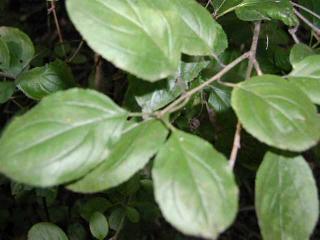|

Shrubs, small trees, and some crawlers (vines) make up
buckthorn. These plants have finely jagged oval leaves. Leaves are
smooth on the upper and lower surfaces. The leaves don't change
color in the fall, but stay green and last until other trees have lost
their leaves.
Common buckthorn has thorns on its twigs. In the spring,
small, white flowers appear on the twigs. Later, in the summer, black,
juicy, bitter berries appear clustered along the twigs.
The buckthorn was introduced to North America as an
ornamental shrub from Eurasia. Because the fruit causes a severe
laxative effect when eaten, birds can readily distribute buckthorn
seeds. Common buckthorn invades mainly woodlands and savannas and
once established it will choke out native shrubs and herbs.
One method to control buckthorn in natural areas is to
do a controlled burn in late March to early May . The best
control, however is prevention. Do not plant buckthorn in your
yard and remove any buckthorn that is growing in your area.
Back
Authors: Laurie Hanson and Melissa Minter. October 2001.
© 2013 Anoka-Ramsey Community College - Biology Department.
The contents of this page have not been reviewed by ARCC.
Last Updated -July 28, 2016
Comments or Problems contact:
Melanie Waite-Altringer or
Joan McKearnan or
Terry Teppen
|